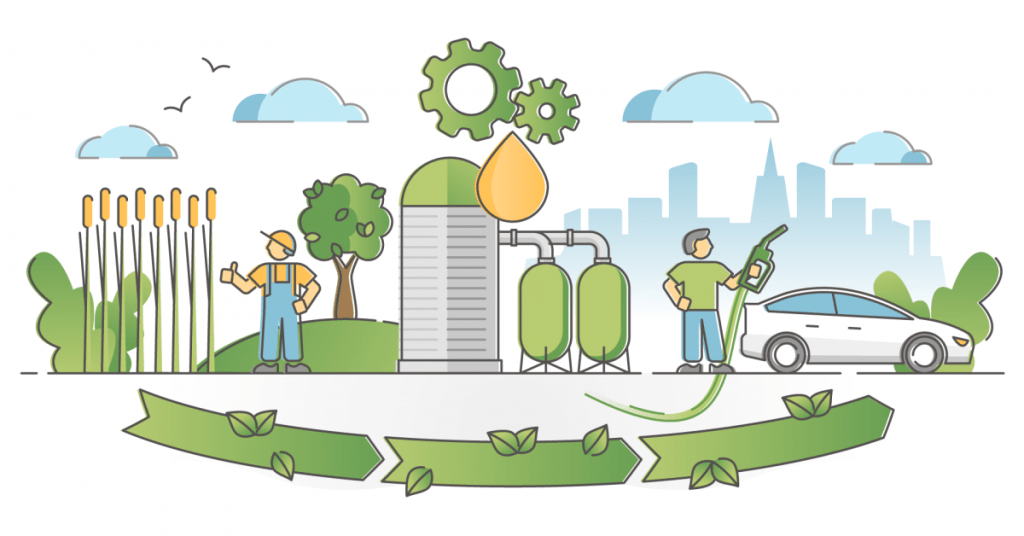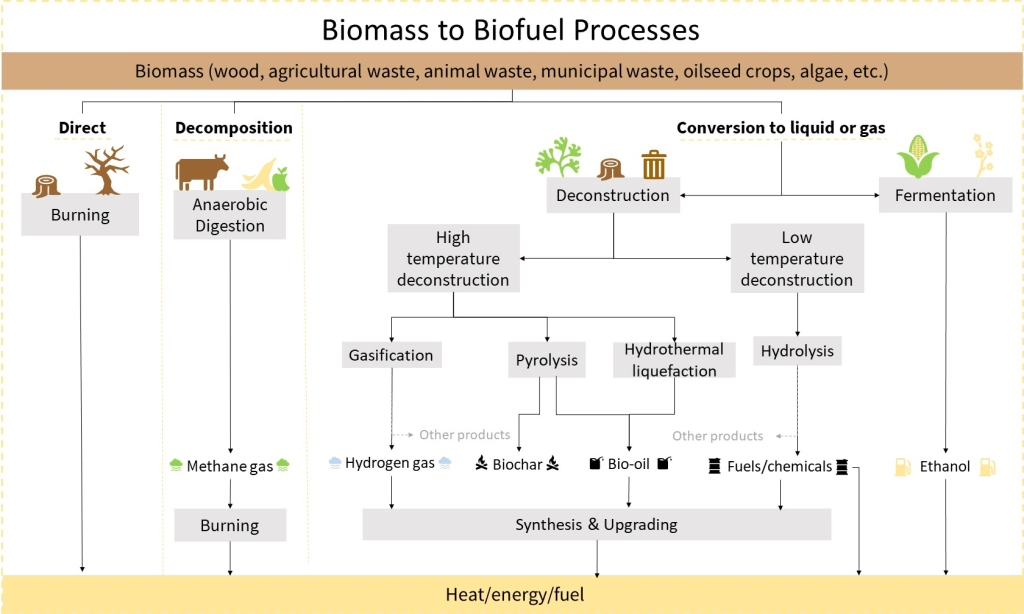In a world growing increasingly concerned about the environmental impacts of burning fossil fuels, a sustainable alternative has been emerging as a beacon of hope – plant-based fuels. We stand at the crossroads of climate change and energy demand. The world is turning its attention towards renewable, eco-friendly energy sources that can reshape the way we power our lives. We have the power to create a world where the fuel powering our vehicles, aircraft, and industries not only produces fewer carbon emissions but also reuses and recycles the very waste materials that contribute to our environmental woes. Plant-based fuels hold the potential to turn this vision into reality. They offer solutions to our transition away from fossil fuels, and ways to transform how we think about energy generation and consumption. It’s time to embrace the power of green energy and ignite a brighter future for generations to come.

Source: DSDILGP
What are Plant-based fuels?
Plant-based fuels (or biofuels) are renewable fuel sources derived from organic matter. This is primarily from a range of crop plants including corn, wheat, sugarcane, and soybeans.
Biofuels can also originate from various other biomasses like algae, trees, and organic waste. They break down these organics through fermentation, chemical reactions, and heating processes. They can then refine the resulting product to produce fuel. Unlike fossil fuels, plant-based fuels produce a lower amount of direct emissions and are a renewable fuel source. Fossil fuels, such as coal, take millions of years to form. Coal holds vast amounts of carbon, which combines with oxygen in our atmosphere when burnt to form carbon dioxide (CO2). When burned, biofuels emit CO2 into the atmosphere, but the organic material used to produce plant-based fuels has the potential to function as a carbon sink during the growth phase, offsetting their emissions.
Types of Plant-Based Fuel
Perhaps the two most well-known plant-based fuels are ethanol and biodiesel. Manufacturers produce ethanol from a variety of crop plants and frequently blend it with gasoline to create a more cost-effective, lower-carbon-emission alternative fuel for vehicles. Producers create biodiesel from vegetable oils and animal fats, offering a cleaner-burning, renewable alternative to petroleum diesel. When blended with gasoline, biodiesel and ethanol can be, and are, used in existing diesel and gasoline engines, respectively. This makes them a practical and accessible option to utilize as we make our transition to cleaner fuels. Biofuels, alongside other renewable fuel options (e.g., electric vehicles), hold the potential to significantly lower the overall emissions of the transportation industry, which currently emits about a quarter of all global energy-related CO2 emissions (IRENA, 2022).

Source: U.S. Department of Agriculture
Plant-Based Fuels: Ethanol
The majority of gasoline around the world contains at least some ethanol. This combination of gasoline and ethanol usually ranges from about E10 (10% ethanol, 90% gasoline) to E85 (85% ethanol, 15% gasoline), depending on the application. In countries such as Australia and the U.S.A., conventional vehicles typically run on ethanol percentages equal to or lower than E10, whereas in countries such as Brazil, fuel contains up to 27% ethanol. Currently, only specialised ‘flex-fuel’ vehicles can run on ethanol percentages as high as E85. Derived from fermenting sugars, ethanol contains oxygen, which assists a car’s engine, allowing it to burn fuel more efficiently while simultaneously reducing air pollution. Studies have shown that the average GHG emissions from corn-based ethanol are 40% lower (including land use change) than conventional gasoline.
Plant-Based Fuels: Biodiesel
Biodiesel can also be blended with other fuels. In this case, that fuel is petroleum-based diesel. Common biodiesel blends range anywhere from B2 (2% biodiesel, 98% petroleum diesel) to B100 (pure biodiesel). Just about every diesel vehicle approves blends of up to B5, and approximately 80% of original equipment manufacturers endorse biodiesel blends up to B20. Common road vehicles do not use pure biodiesel, but some types of farm equipment do. Unfortunately, pure biodiesel also has a higher cloud point than petroleum-based diesel. Meaning the fuel can solidify more easily at low temperatures, causing issues in cold climates. Studies comparing emissions of petroleum diesel and biodiesel show that biodiesel produces lower emissions across almost all compounds (Ajala et al., 2015). Additionally, the CO2 that is released through the combustion of biodiesel is mostly offset by the CO2 absorbed by the feedstock during the growing process.

Source: Energy.gov.
Plant-Based Fuels: Other Options
People commonly use ethanol and biodiesel as plant-based fuels, but the energy industry also applies numerous other options. Renewable gas (biomethane) results from a treatment process applied to biogas. This process eliminates impurities like CO2, rendering it a combustible gas. This process makes it a slightly cleaner and more renewable alternative to fossil gas. Biomethane has applications in transport and energy generation. It stems from decomposing organic remains, such as agricultural and livestock waste or sludge from water treatment plants. The aviation industry has employed other types of plant-based fuel, but in 2018, biofuel production for aviation accounted for only 0.1 % of total fuel consumption, indicating ample room for upscaling.
the future of plant-based fuels: room for improvement
The invention of biofuels predates the first automobile. However, their widespread adoption has remained limited due to the historically low cost of gasoline and diesel. In the present day, biodiesel’s price sits approximately 70% to 130% higher than that of gasoline and petrol. There are high costs associated with the purification process, and the production of the organic materials used to create the fuel primarily causes this situation. Ethanol prices are slightly lower in some countries and often fluctuate to values higher or lower than gasoline. Whereas in other areas, such as Europe, ethanol production is also about two times higher than gasoline.
The concept of utilising agricultural land to grow fuel instead of food presents its own set of difficulties. Biofuel production dependent on waste or other feedstocks has not yet managed to match the cost and scale of traditional fuels. More research is required to improve the technology of production and purification for biofuels in order to reduce their costs. We need research to be cheaper and more sustainable feedstock. Studies into alternatives such as algae are showing promising results (CSIRO, 2021). Major car manufacturers are also a constant threat to the biodiesel industry. Global legislation is still stagnant on policies and promotion of alternatives within the vehicle manufacturing industry.
achieving the United Nations Sustainable Development Goals (SDGs) and how they link to Plant-based fuels
The United Nations’ seventh sustainable development goal is to “ensure access to affordable, reliable, sustainable and modern energy for all” (UN, 2012). Biofuels hold the potential to play a significant role in achieving this goal. This can be done through contributing to both sustainable energy production and consumption. Fully achieving this potential will require continued research into feedstock options, production methods, and land use practices. This will help us to identify options that are not only affordable but also reliable and sustainable.
It is essential moving forward that we implement meaningful biofuel policies and practices. They should prioritize sustainability, environmental protection, and social equity. This will ensure that biofuels can have a positive contribution towards achieving SDG number 7, and other related goals.
A Thrivable Framework
The THRIVE Project is all about creating a future in which humans can not only survive but also thrive. THRIVEs interests lie with issues essential to the integrity of our society as a whole. This includes not only sustainability but also safeguarding all aspects of human well-being and their rights.
The THRIVE Project strives for thrivability. Plant-based fuels assist in this vision of thrivability by providing a pathway to transition away from finite energy sources. Proper utilisation of plant-based fuels can ensure a future in which all humans have access to clean and affordable energy.
The THRIVE framework recognises that here on Earth, we have finite resources. Our current way of living is riddled with unrealistic processes that threaten our longevity. The THRIVE framework suggests a circular consumption model that moves away from this linear trend. The THRIVE framework examines issues and evaluates potential solutions through analysis of technologies such as plant-based fuels.
If you would like to learn more about how our research works at The THRIVE Project visit our website. Additionally, you may follow our educational podcast series and blog articles, and sign up for our newsletter for regular updates.























